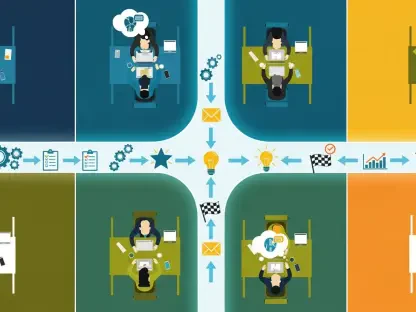In an era marked by unprecedented technological advancements and shifting work paradigms, organizations are constantly adapting to change. Amid these transformations, maintaining effective communication has become crucial for navigating the complex landscape of workplace evolution. Companies face mounting pressures, from embracing remote work models and integrating artificial intelligence to managing organizational restructuring. Each of these challenges underscores the importance of strategic communication. The ability to convey clear, coherent messages not only aids in implementing changes but also helps in preserving company culture and morale. As modern workplaces evolve, understanding how communication shapes these transformations becomes a pivotal consideration for leaders aiming to facilitate smooth transitions and achieve long-term success.
The Dynamics of Remote Work and In-Person Collaboration
In the wake of widespread remote work adoption, organizations are reevaluating the merits of in-person and virtual office setups. As companies explore hybrid models, effective communication becomes indispensable in balancing these formats. For example, the Royal Bank of Canada’s decision to bring employees back to the office reflects a commitment to face-to-face interactions. This move aligns with the belief that in-person collaboration fosters creativity, collaboration, and a robust company culture — elements that digital communications sometimes struggle to replicate. Subsequently, communicating the rationale behind such decisions clearly to employees can mitigate resistance and promote understanding.
While remote work offers unmatched flexibility, the hybrid model aims to retain the benefits of both remote and in-office settings. Clear communication strategies are essential for conveying logistical aspects such as work schedules, expectations, and protocols. This transparency encourages employees to adjust smoothly to hybrid arrangements, reducing potential confusion or friction. Furthermore, effective communication helps in integrating remote practices with traditional office culture, ensuring that neither aspect undermines the other. In doing so, organizations foster an environment where collaboration thrives, both virtually and in person, catering to diverse employee preferences and enhancing overall productivity.
Strategic Layoffs and Transparent Communication
Implementing significant organizational changes, including layoffs, involves challenges that demand careful handling to maintain trust and morale. Effective communication plays a central role here, especially in situations like Business Insider’s layoff announcement, which was managed with transparency and empathy. By openly sharing the reasons behind workforce reductions, organizations can foster trust and demonstrate respect for their employees. A transparent communication approach, even in challenging times, helps maintain goodwill and protects the company’s public image. When leaders articulate the strategic necessity behind such decisions, employees are more likely to understand and accept the changes.
Moreover, conveying a clear and structured plan for affected employees — such as severance packages, job placement assistance, and re-skilling opportunities — further reinforces an organization’s commitment to supporting its workforce. The importance of personal connection cannot be overlooked, especially in times of upheaval. Leaders who engage openly and directly emphasize the human aspect of their organizations, showing consideration and empathy in the face of change. This earnest approach not only serves to ease transitions but also showcases a model of leadership that values its workforce, thus setting a new standard for handling corporate restructuring with integrity.
The Role of AI and Ethical Communication in the Workplace
The integration of artificial intelligence into daily operations presents both opportunities and challenges for modern businesses. In many workplaces, employees utilizing AI tools often do so without formal approval due to fears associated with job security and the absence of clear guidelines. This clandestine use of AI highlights a pressing need for open dialogue and ethical frameworks to guide technology use. Organizations benefit from transparent and informative communication that clarifies AI’s role within the workplace, dispelling misconceptions and encouraging responsible adoption. By fostering an environment of open discourse, organizations ensure that AI integration aligns with employee expectations, corporate values, and ethical standards.
Internal communicators are pivotal in the development and implementation of comprehensive AI policies. They can facilitate conversations around the responsible use of AI, balancing innovation with necessary oversight. Their role extends to crafting messages that reassure employees about job security while highlighting the efficiency and productivity gains AI can offer. The aim is to cultivate a culture of openness regarding emerging technologies, ensuring transparency and accountability in their application. As AI becomes increasingly embedded in workplace routines, organizations must communicate not only the technical advantages but also address any ethical considerations, paving the way for a trusting and innovative work environment.
Navigating Change with Communication as a Bridge
With the rise of remote work, businesses are rethinking the advantages of physical versus online office environments. As they lean towards hybrid models, efficient communication is key to balancing these setups. Take the Royal Bank of Canadthey’re pulling employees back into the office, supporting the viewpoint that in-person meetings boost creativity, teamwork, and a strong corporate culture. These are aspects that digital platforms sometimes can’t fully replicate. Sharing the reasoning behind such choices openly with employees helps minimize resistance and fosters understanding.
While remote work offers significant flexibility, the hybrid approach seeks the best of both in-office and remote worlds. Clear communication is vital in detailing work schedules, expectations, and protocols. This openness allows employees to adapt to hybrid models smoothly, minimizing confusion. Additionally, effective communication is crucial for blending remote work practices with traditional office culture, ensuring both coexist without hindrance. This creates an environment where collaboration thrives, accommodating diverse employee preferences and boosting overall productivity.









